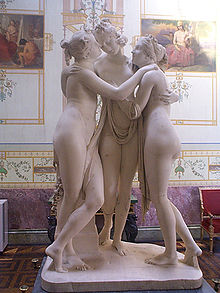Aglaea

Aglaea(/əˈɡliːə/) orAglaïa(/əˈɡlaɪə/;Ancient Greek:Ἀγλαΐα,lit. 'festive radiance'[1]) is one of the threeCharitesinGreek mythology,also called theGratiae(Graces) inRoman mythology.
Family
[edit]According toHesiodand other sources (includingApollodorus), Aglaea was one of the three Charities, along withEuphrosyne(mirth) andThalia(abundance), who were the daughters ofZeusand theOceanidEurynome.[2][3][4][5]Other sources name the same three Charites (Aglaea, Euphrosyne and Thalia) but give them different parents. TheOrphic Hymnto the Graces says they are the daughters of Zeus andEunomia(goddess of good order and lawful conduct),[6]andPindarsays that they are daughters of the strongest god (i.e. Zeus) without naming their mother.[7]Hesiod says also that Aglaea is the youngest of the Charites.[8][1][4][9][10]
According to theDionysiaca,Aglaea is one of the "dancers ofOrchomenus"(i.e. the Charites, per Pindar[7]), along withPasitheaandPeitho,who attendAphrodite.When Aphrodite jealously attempts to weave better thanAthena,the Charites help her do so, with Aglaea passing her the yarn.[11]Aglaea also acts as Aphrodite's messenger, and is sent to find and bring a message toEros,who travels back to Aphrodite much faster because he can fly whereas Aglaea cannot. Aglaea here is referred to as aCharis(singular of Charites), but other characters not of this group are also namedCharis,including by Aglaea.[12]
Hesiod says that Aglaea was married toHephaestus.[8](This is often seen as after his divorce from Aphrodite.) TheOrphicFragments compiled byOtto Kernsay that by Hephaestus, Aglaea became mother ofEucleia( "Good Repute" ),Eupheme( "Acclaim" ),Euthenia( "Prosperity" ), andPhilophrosyne( "Welcome" ).[13]TheIliadandDionysiacarefer to the wife of Hephaestus asCharis,[14][15]and some scholars conclude that these references refer to Aglaea.[4]
Notes
[edit]- ^abBrill's New Pauly,s.v. Aglaea (1).
- ^Hesiod,Theogony907
- ^Apollodorus,1.3.1.
- ^abcBell,s.v. Aglaia (1), p. 15.
- ^Brill's New Pauly,s.v. Charites (Graces).
- ^Orphic Hymn(60),2–3.
- ^abPindar,Olympian Ode14.1–20.
- ^abHesiod,Theogony945.
- ^Hard, pp.167,208
- ^Smith,s.v. Charis
- ^Nonnus,Dionysiaca24.254 ff.
- ^Nonnus,Dionysiaca33.51 ff.
- ^Orphicfr. 182 Kern, p. 213(English translation).
- ^Homer,Iliad18.382–385
- ^Nonnus,Dionysiaca29.317
References
[edit]- Apollodorus,The Librarywith an English Translation by Sir James George Frazer, F.B.A., F.R.S. in 2 Volumes, Cambridge, MA, Harvard University Press; London, William Heinemann Ltd. 1921. ISBN 0-674-99135-4.Online version at the Perseus Digital Library.Greek text available from the same website.
- Bell, Robert E.,Women of Classical Mythology: A Biographical Dictionary,ABC-Clio,1991.ISBN978-0-874-36581-8.Internet Archive.
- Brill’s New Pauly: Encyclopaedia of the Ancient World. Antiquity, Volume 1,A-Ari, editors: Hubert Cancik, Helmuth Schneider,Brill,2002.ISBN978-90-04-12258-1.Online version at Brill.
- Grimal, Pierre,The Dictionary of Classical Mythology,Wiley-Blackwell, 1996.ISBN978-0-631-20102-1.Internet Archive.
- Hard, Robin,The Routledge Handbook of Greek Mythology: Based on H.J. Rose's "Handbook of Greek Mythology",Psychology Press, 2004.ISBN978-0-415-18636-0.Google Books.
- Hesiod,TheogonyfromThe Homeric Hymns and Homericawith an English Translation by Hugh G. Evelyn-White, Cambridge, MA.,Harvard University Press; London, William Heinemann Ltd. 1914.Online version at the Perseus Digital Library.
- Kern, Otto,Orphicorum Fragmenta,Berlin, 1922.Scans at the Internet Archive,English translation at HellenicGods.org.
- Nonnus of Panopolis,Dionysiacatranslated by William Henry Denham Rouse (1863–1950), from the Loeb Classical Library, Cambridge, MA, Harvard University Press, 1940.Online version at the Topos Text Project.
- Pindar,Odestranslated by Diane Arnson Svarlien. 1990.Online version at the Perseus Digital Library.
- Pindar,The Odes of Pindarincluding the Principal Fragments with an Introduction and an English Translation by Sir John Sandys, Litt.D., FBA. Cambridge, MA., Harvard University Press; London, William Heinemann Ltd. 1937.Greek text available at the Perseus Digital Library.
- Smith, William;Dictionary of Greek and Roman Biography and Mythology,London (1873)."Charis".
